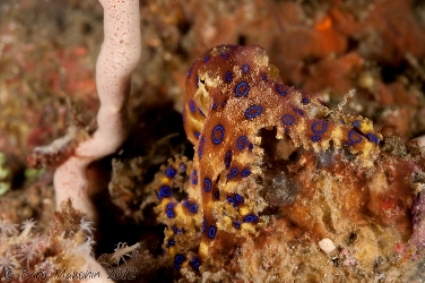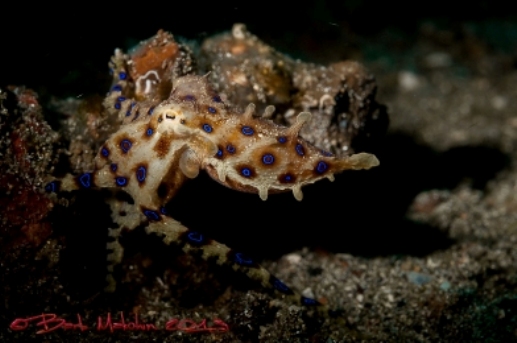Classification
Scientific Name: Hapalochlaena lunulata
Meaning of Hapalochlaena: Latin for "Soft-skinned" (latindiscussion.com)
Meaning of lunulata: Latin for "Little moons" (latindiscussion.com)
Common Name: Greater Blue-ringed Octopus
The common name of the Hapalochlaena lunulata comes from
the amount of blue rings it has on the surface of its
skin when it is disturbed (Aquarium
of the Pacific). There is no knowledge of who
discovered this species.
Classification:(Encyclopedia of Life 2013)
Kingdom: AnimaliaPhylum: Mollusca
Class: Cephalopoda
Order: Octopoda
Family: Octopodidae
Genus: Hapalochlaena
Species: Hapalochlaena lunulata
Characteristics of Each Taxonomic Level:
Kingdom: Animalia
Hapalochlaena lunulata are a part of the kingdom Animalia. There are several characteristics that define the kingdom Animalia that include their mulitcellularity, eukaryotic cells, and heterotrophic feeding styles (ZipcodeZoo 2012). Most animals rely directly or indirectly on other organisms for nutrition. They mainly ingest food and digest it in an internal cavity. Animal cells don't have a cell wall like plant cells (Encyclopedia of Life). Animal's bodies (except sponges) are made up of cells that are organized into tissues, that have a specialization to some level to perform precise functions (Encyclopedia of Life).
Phylum: Mollusca
According to the latest of scientific understanding,
the Mollusca group is said to total about 55,000 species
in eight diverse classes (The Living World of Molluscs). The common
characteristics all these organisms share has led
naturalist Georges Cuvier to found a new phylum called
Mollusca, meaning "soft animals", from the Latin word
mollis for soft (The Living World of Molluscs).
All of the animals in the phylum Mollusca include
octopuses, squid, clams, oysters, snails, and chitons.
Molluscs are organisms that have soft bodies which
typically have a "foot" and a "head" region (University
of California Museum of Paleontology). Molluscs
occur in
almost every habitat on Earth.
phylum called
Mollusca, meaning "soft animals", from the Latin word
mollis for soft (The Living World of Molluscs).
All of the animals in the phylum Mollusca include
octopuses, squid, clams, oysters, snails, and chitons.
Molluscs are organisms that have soft bodies which
typically have a "foot" and a "head" region (University
of California Museum of Paleontology). Molluscs
occur in
almost every habitat on Earth.
Class: Cephalopoda
Cephalopoda translated into English means "head foot" and these organisms have the most complex brains of any invertebrate in the animal kingdom (Aquarium of the Pacific). They are characterized by their completely merged foot and head with a beak, with muscular tentacles surrounding the head and/or a ring of arms (Aquarium of the Pacific). The tentacles, arms, and funnel are all offshoots of the foot (Encyclopedia of Life).
Order: Octopoda
The order called Octopoda refers to
octopuses that consist of two eyes, four pairs of arms
and bilateral symmetry (Encyclopedia
of Life). An octopus is made up of a completely
merged foot and head with a hard beak, and its mouth at
the center of its muscular tentacles (Aquarium
of the Pacific).
(Aquarium
of the Pacific).
Family: Octopodidae -
The name Octopodidae simply refers to a family of the order Octopoda (Merriam-Webster).
Genus: Hapalochlaena
The word Hapalochlaena roughly translated into English means soft-skinned thing. The name refers to the soft papillae covering the mantle of this octopus and others in the same genus (Latindiscussion.com). This particular octopus in this Genus has the characteristics of a small body size and the most venomous species of octopi (The Cephalopod Page).
Species: Hapalochlaena lunulata
The binomial name Hapalochlaena lunulata means soft-skinned thing covered in small moons. It was named as such due to the size of the vivid blue rings that give the impression of bright, full moons (Latindiscussion.com). This species of octopus is 20 cm (7.87 in) at maximum spread (Encyclopedia of Life). The body is often covered with papillae that give it a rough appearance with up to 25 faint blue rings as large as 8mm (0.8 cm) in diameter that cover the entire surface of the octopus's skin (Aquarium, of Pacific).
Now that you have learned about this species classification, please continue on to tread about this octopus's Habitat.
